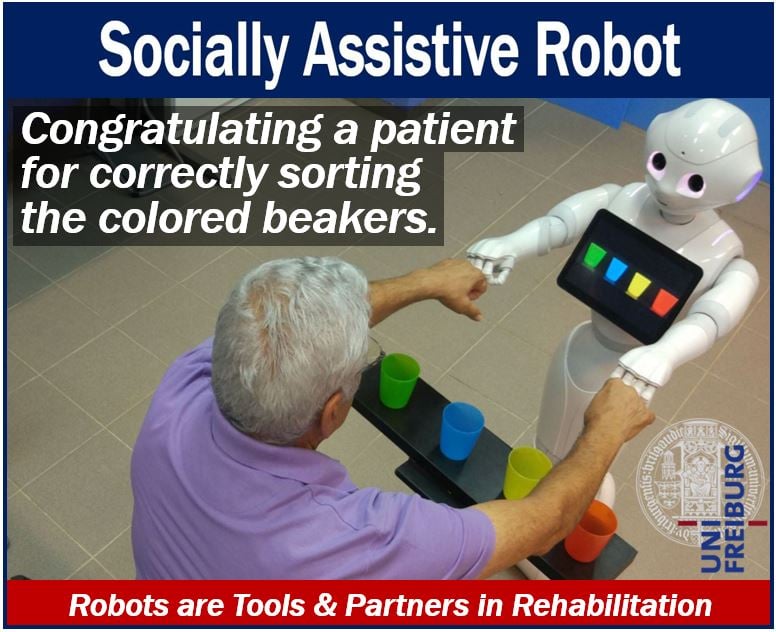Socially Assistive Robots will become more common in future decades. They will become more common because patients’ survival rates after diseases are increasing. Specifically diseases with severe functional deficits such as stroke. We are already starting to use socially assistive robots for patients with functional deficits for this reason.
The inability to walk without assistance or reach up to shelves in the kitchen, for example, are functional deficits.
SAR stands for Socially Assistive Robot. We are using SARs today widely in rehabilitation.
Dr. Philipp Kellmeyer and Prof. Dr. Oliver Müller wrote about their study on socially assistive robots in the journal Science Robotics (citation below). They analyzed the improvements that will be necessary to make SARs reliable and valuable assistants for medical therapies.
Dr. Kellmeyer works at the Freiburg University Medical Center. Prof. Dr. Müller works at the Department of Philosophy of the University of Freiburg. Freiburg is a university city in Germany.

Development of Socially assistive robots
The authors conclude that SARs development not only requires technical improvements but also social and trust-building measures.
Rehabilitation patients are very dependent on a reliable relationship with their therapists. Therefore, there must be trust in the safety of socially assistive robots. Patients must be able to predict the robots’ behavior.
This is extremely important, given robots’ ever-growing intelligence. If a robot becomes more intelligent, it subsequently also becomes more independent.
Socially assistive robots have artificial intelligence or AI. AI refers to software technologies that make devices, such as robots, think and behave like humans.
Socially assistive robots and patients
Additionally, the authors explain, robots and patients can only interact well when they have shared goals. Specifically, shared goals that they pursued via therapy.
To achieve this, we must take into account not only aspects of developmental psychology but also philosophical psychology when developing SARs.
To adapt there must be trust
Socially assistive robots must be able to recognize patients’ aims and motives for successful cooperation. Therefore, there must also be trust for patients and socially assistive robots to adapt to one another.
Robots must be able to adapt to the specific needs and vulnerabilities of each of patient. Only then is it possible to avoid patient frustration due to their linguistic or physical limitations.
Prof. Dr. Shelly Levy-Tzedek and Ronit Feingold-Polak from the Ben Gurion University of the Negev, Israel, also participated in the study.
Research Focus
The Freiburg researchers are developing a Research Focus into normative aspects of interaction between people and robots. The Research Focus will be at the Freiburg Institute of Advanced Studies. The researchers will be working with Prof. Dr. Wolfram Burgard, an IT specialist, and Prof. Dr. Silja Vöneky, a legal academic.
What is a robot?
Robots are machines or devices that we can usually program. We program them to do things. Some robots have artificial intelligence.
A ‘humanoid‘ robot is one that has arms, legs, a head, and torso. In other words, it has a human-like shape.
Robots that work with people, especially children, tend to be humanoid. In factories, on the other hand, they are not humanoid.
Citation
“Social robots in rehabilitation: A question of trust,” Philipp Kellmeyer, Oliver Mueller, Ronit Feingold-Polak, and Shelly Levy-Tzedek. Science Robotics, 15 Aug 2018: Vol. 3, Issue 21, eaat1587. DOI: 10.1126/scirobotics.aat1587.

